A specially created grassy carpet, trimmed straight and short, is called a lawn on a certain piece of land. This is one of the most important elements of landscaping and garden landscape design. Thanks to him, all the elements of the garden are successfully combined into one whole. Colors and shades, the texture of crowns and leaves play in a completely new way. Against the background of an absolutely flat lawn surface, other forms of plants become more expressive.
Arrangement of the lawn in the garden is not only decorative and compositional in nature, but also contributes to an increase in air humidity, improves the microclimate of the backyard territory.
The arrangement of the lawn is not an easy task. Often summer residents run into problems:
- sown ornamental grass - pets trampled;
- did not sprout a mixture of grasses for the lawn - dug up;
- the lawn sprang up, but it was overgrown with weeds - I had to plow;
- grass sprouted, but grew into bumps- the mice are wound up.
The options for creating a lawn depend on the owner's intentions. You can do this in several ways:
- cheap - budget, long and not very high quality;
- at an average price, after three summer months, but much cleaner;
- expensive, in a couple of weeks, high quality and spectacular - without the presence of weeds.
In this case, take into account not only the desires and budget allocated for the installation of the lawn, but also the environmental friendliness of different types of coatings and grass preparations.
Classification of lawns in the landscape
Sowing lawns are created mainly by sowing a mixture consisting of seeds of perennial herbaceous plants (less often annuals). The selection of the grass mixture used for sowing depends on the climatic features and characteristics of the soil, as well as determining the purpose of the lawn and lighting conditions.
Table 1. Classification of lawns by purpose
| Decorative | Parterre |
| Meadow (Moorish) | |
| Universal | Classic (park or garden) |
| Wild | |
| Functional | Sporty |
| Fertilized | |
| Another view |
With decorative types of lawns, everything is clear - they are used for aesthetic arrangement of the territory in order to give it a new attractive look. On a green backgroundarchitectural structures and decorative elements look much better than in an unennobled area.
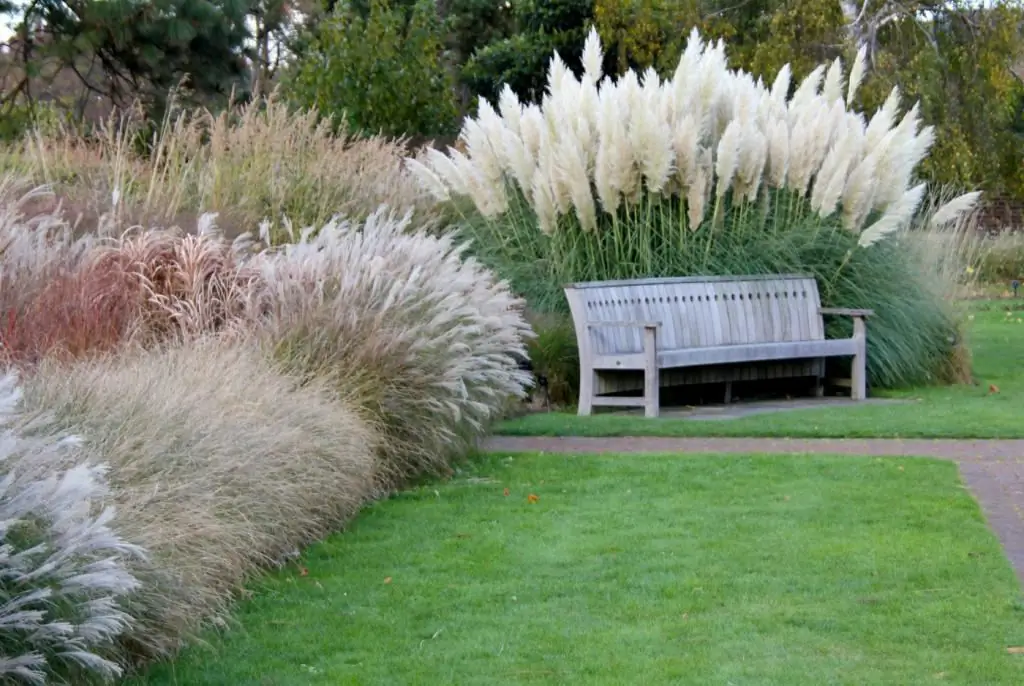
Universal, characterized by relative resistance to damage, while remaining quite decorative. Also fits perfectly into the category of aesthetic lawns for landscaping.
A functional lawn is designed to perform a specific task. For example, for arranging a sports ground, football field, strengthening slopes, slopes, turfing outskirts and roads, gently sloping banks of water bodies.
Sowing seeds for turfing is not the only way to create a beautiful decorative surface in your backyard. In addition to sowing a special grass mixture, you can take a specially grown turf and lay it on the desired area. The advantage of this option is the arrangement and layout of the lawn in an extremely short time.
Table 2. Lawn classification by location
| Light-loving | Outdoors only. |
| Shade Tolerant | Suitable for arranging a lawn on a plot shaded by trees and shrubs or buildings. |
Some recommendations for arranging a lawn in the country
Use grass mixtures that are compatible with the type of soil prevailing on the site. Each collection contains specific herbs that differ in naturalrequirements, but they are all grouped according to the rate of growth, development, response to the environment, stress resistance. Some of them are moisture-loving and shade-tolerant plants, suitable for sodding the garden and shady plots of home gardens, others are drought-resistant and photophilous and are suitable for sowing in open areas.
For example, in areas with partial shade, sow grass mixtures that are dominated by red fenugreek or bluegrass seeds.
Today, the range of grass mixtures provides an opportunity to choose any of the appropriate options. Seed bags are labeled as intended for universal, parterre or park lawn.
Table 3. Classification by turf method
| Seeded | Charges sown on the prepared site. |
| Rolled | Rolls of turf (lawn) stacked on the prepared area. |
A few words about the component composition - lawn grasses
Lawns are also different from each other, even if visually their differences are barely noticeable. The main difference is the species and varietal diversity of cereal grasses that are part of the mixture for sowing. It is not difficult to sow the prepared site, here it is much more important to choose exactly the mixture that you need. Do not take this matter lightly, otherwise you risk ruining the entire lawn installation process.
When buying an herbal mixture, do not exaggerate with bright colorful patterns on the package. The only thing,what really deserves attention is the summary of the bag of seeds.
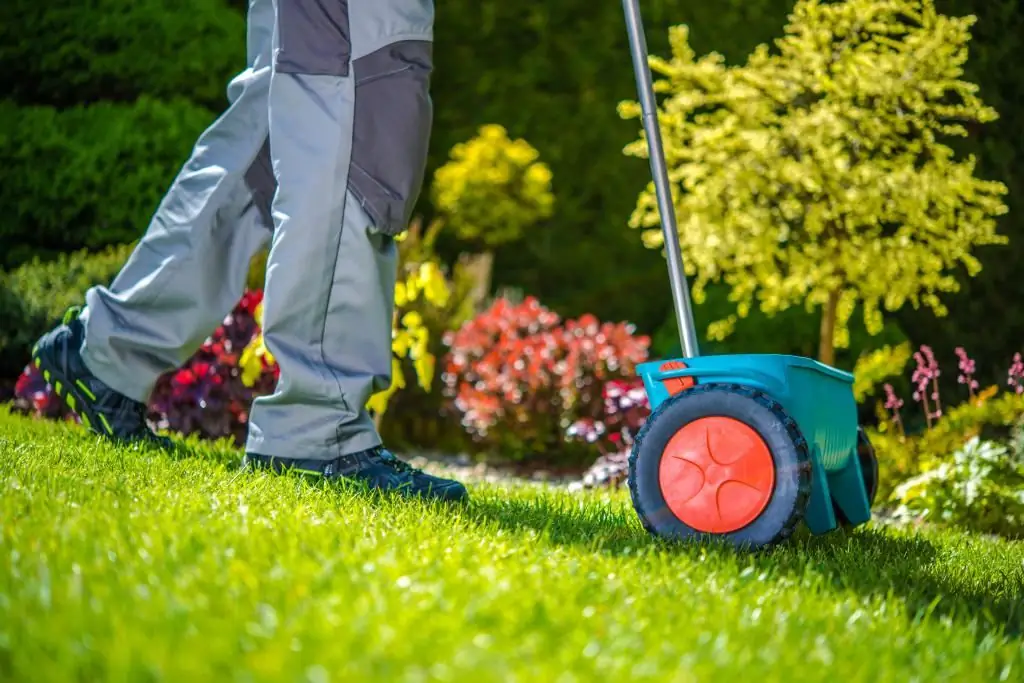
Distinctive features of the parterre lawn
This is a first class or top class lawn type. They are given a central place in the architectural composition of the garden, near a fountain or an ornamental pond.
A characteristic feature of the parterre lawn is the predominance of the area over other components of the landscape. This is the main element of the parterre or flower garden, serving as a backdrop for flower arrangements and green spaces, ornamental bushes, trees, sculptures, fountains.
Characteristics of an ordinary (classic) lawn
Gardening and park green lawn is classified as a number of coatings of the second class. They should be:
- decorative;
- long-term;
- be resistant to drought and mechanical damage.
When choosing a lawn seeding mix, remember that it should be selected with a strong turf and different types of tillering grasses, which will contribute to better germination and penetrating the soil with plant roots.
For a classic lawn, the choice of mixtures is wider, therefore it is worth studying the description for seeds more carefully. Having found pasture ragries in the composition, be guided by the fact that the cover of the future lawn forms a strong crust of grasses, but will not be completely uniform in color.
The subtleties of caring for the "wild" lawn
This name refers to the use of grass for the lawn from the genus of weeds. In this case, it will not be superfluous to purchaselawn mowers or just household mowers for systematic lawn mowing - twice a month. Also, a mini tractor for mowing the lawn is useful on the farm.
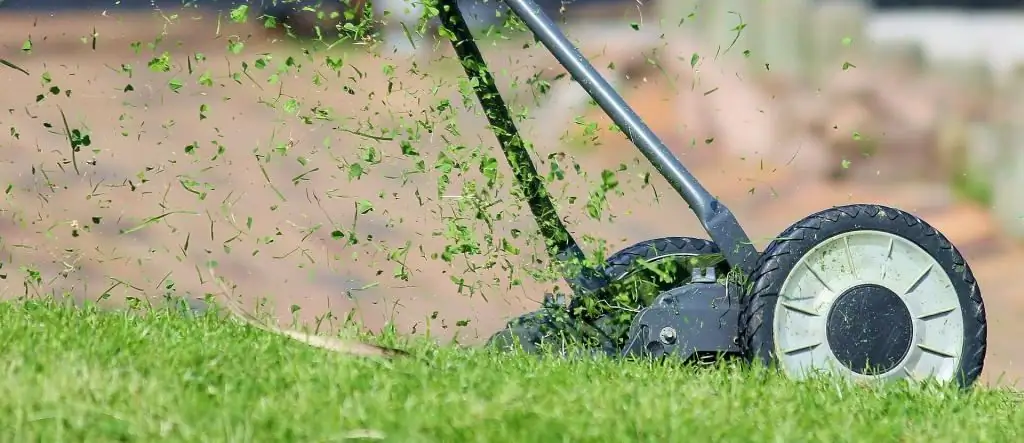
Watch out for particularly harmful weeds:
- horse sorrel;
- burdock;
- ambrosia;
- hogweed.
As far as possible, get rid of them so as not to attract small pests and insects to the house. If you are a particularly evil esthete, then do not disdain sow thistle, thistles, dandelions.
First, take on the removal of especially large species of weeds. Level the structure of the lawn. At the same time, do not forget about removing bumps and places of stagnant water.

Distinctive features of Moorish lawn
Meadow lawn is created by improving the existing grass stand. Moorish lawns can be created from lush grasses, which in reality looks like a picture from a movie with beautiful flowering meadows and lawns.
In the composition of meadow (Moorish mixtures) perennial cereals (80-95%), and not always lawn selection, and seeds of wild wildflowers (5-20%). Plants for grass on the lawn are selected with different flowering periods, which allows for an attractive decorative appearance of the site throughout the season. For example, blue cornflowers bloom from late May to July, and from the beginning of summer large-flowered flax comes into bloom, which pleases with bright red "lights" until the end of August. Organically complements the composition of nigelladamask as a white and pink background.
Sports turf features
The name of this kind of lawn speaks for itself. The coating is used for covering golf courses and football stadiums, sports grounds for various purposes.
Cereal seeds are used to form a dense coverage of a sports lawn. The highest resistance to moisture absorption is shown by perennial ryegrass, sheep and red fescue, bluegrass meadow, which makes up to 50% of this cocktail. In shady areas, lawn grasses are sown in special proportions.
Roll Coating
The technology of laying the lawn with rolled sheets is fast. Rolled turf flooring is grown specifically for this purpose in nurseries. The main advantage of covering over a seeded lawn is the ability to break up the lawn in just a couple of days.
Ask: how to make a lawn? In this case, everything is simple. 75% of estate owners do without outside help in this matter. The only condition is the immediate installation of the rolls delivered to the place of laying. Even a slight delay causes self-warming of the grass rolled into rolls and the drying of the green "carpet".
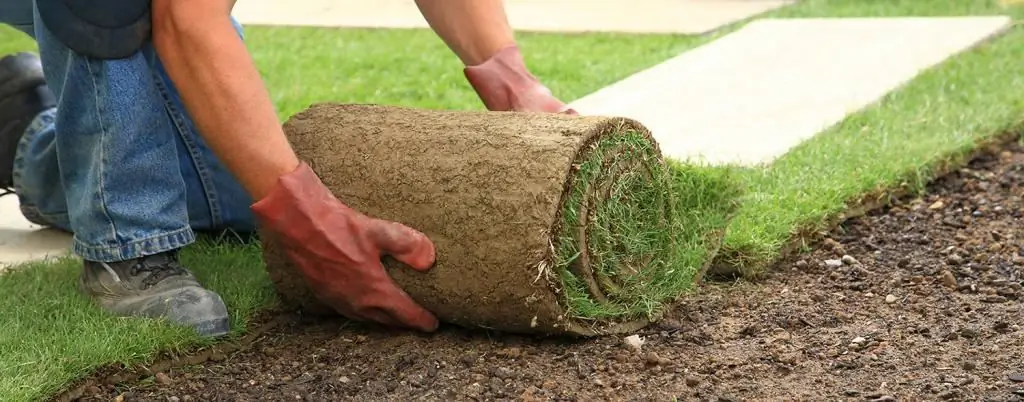
How to prepare the soil for laying or sowing grass
Arrangement of the lawn at this stage is considered the most difficult and time-consuming. Therefore, it requires special attention in the implementation of work. Here it is important to achieve an absolutely flat surface of the site with a fertile layer of soil up to 15 cm, having previously cleared it of roots and debris.
Onclay soils, care should be taken to exclude the possibility of the formation of puddles. For the last 2-3 weeks, focus on killing weed residues with herbicides before proceeding with any further soil preparation.
Lawn drainage system
To achieve high-quality drainage, proceed as follows:
- Remove the top fertile soil layer up to 15 cm and set it aside.
- Think about how and where water flows after watering the lawn. Provide necessary slopes.
- Pour a layer of gravel, stones or broken bricks up to 15 cm thick on the lower layer of the earth and tamp it down.
- Lay a sand cushion up to 10 cm thick on top and compact it.
- Lay the fertile layer of soil in place, level and walk over the top of the roller. This device is easy to replace, taking, for example, a barrel filled with water. Don't forget to close the drain hole in the container before you start compacting the turf area.

Soil selection and why it matters
Many people say that lawn grass is not whimsical and grows well on any soil. But this option only works when you need to aesthetically hide some areas of the site or garden.
To keep your lawn happy for more than one year, take care of the preparation of the soil-soil mixture, as well as for any other living plant that you are going to plant on the site.
In modern conditions on a country site or a summer residence,especially after construction works, the natural fertile soil layer is severely disturbed or completely absent. Therefore, to create a beautiful sowing lawn, bring special fertile soil to the site.
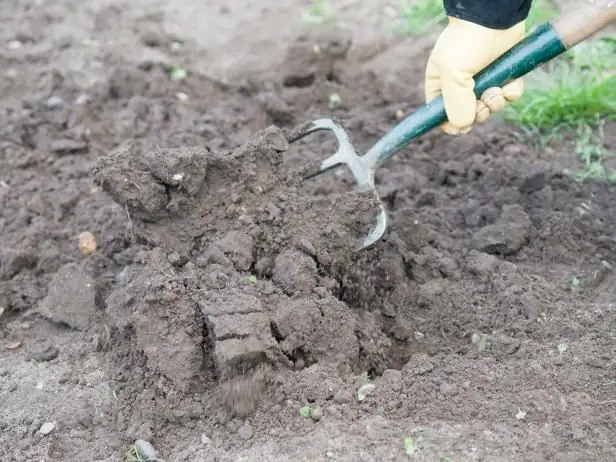
The soil must meet the following specifications:
- have a mean density;
- bulk mass should be 0.8-1.2;
- be air and water permeable;
- be characterized by a neutral pH reaction;
- contain the necessary supply of nutrients in sufficient quantities.
A specially prepared peat-sand mixture is suitable for these requirements, consisting of:
- 1 pieces of peat;
- 1 pieces of sand;
- 1 piece of sod land;
- lime;
- set of mineral fertilizers.
If there are not enough nutrients, special lawn fertilizers will have to be applied.
How to deal with weeds
Lawn care in the summer requires special attention, starting from the moment the site is prepared for sowing grass.
At each stage, including when digging or moving the soil, try to completely remove the roots of perennial weeds. Being unsure of the cleanliness of the flooring under the lawn, carry out a special digging. After digging the soil, water for several days. This stimulates the growth of the remaining weeds, after which you can easily remove the remaining parasitic plants.
Go aheadchemical treatment. After waiting for dry, calm weather, spray the soil with solutions containing herbicides. You can use Roundal or Tornado. The duration of the reaction is up to 7 days. During this period, up to 90% of weeds die. It takes up to 28 days to breed the remaining persistent perennial species. In this case, the processing is carried out every seven days.
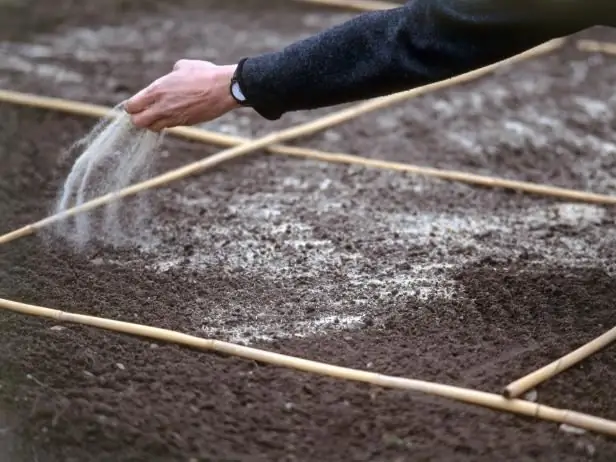
Be aware that warm rainy weather promotes germination of weed seeds, which leads to the need for re-herbicide treatment. Having completed the fight against harmful plants, dig up the soil. Starting the procedure, heavy clay soils are diluted with sand, adding from 10 to 15 kg of sand per 1 m2 2, and light sandy soils with peat, adding 4-5 kg per 1 m2 2. At the next stage, the earth is dug to a depth of up to 27 cm. Therefore, with a fertile layer of less than 15 cm, keep the soil in reserve. For example, to add 1 weave of land with a layer of soil up to 10 cm thick, you will have to spend at least 10 m3 fertile soil.
After that, start sowing or leave the plot until spring. So you don't have to do separate lawn care in winter.
Subtleties of sowing
Spring or late summer is the best time to sow seeds. Although this can be done in the middle of summer, but in this case, regular watering of seedlings is required (especially in drought). The period of grass germination increases with the approach of autumn, so calculate the time so that the green mass has time to rise to 10 cm. Note that pre-winter sowing is landscapedesigners strongly discourage. Due to the decrease in temperature, which sometimes reaches extreme levels, up to 60% of the seeds die, and the rest sprout unevenly.
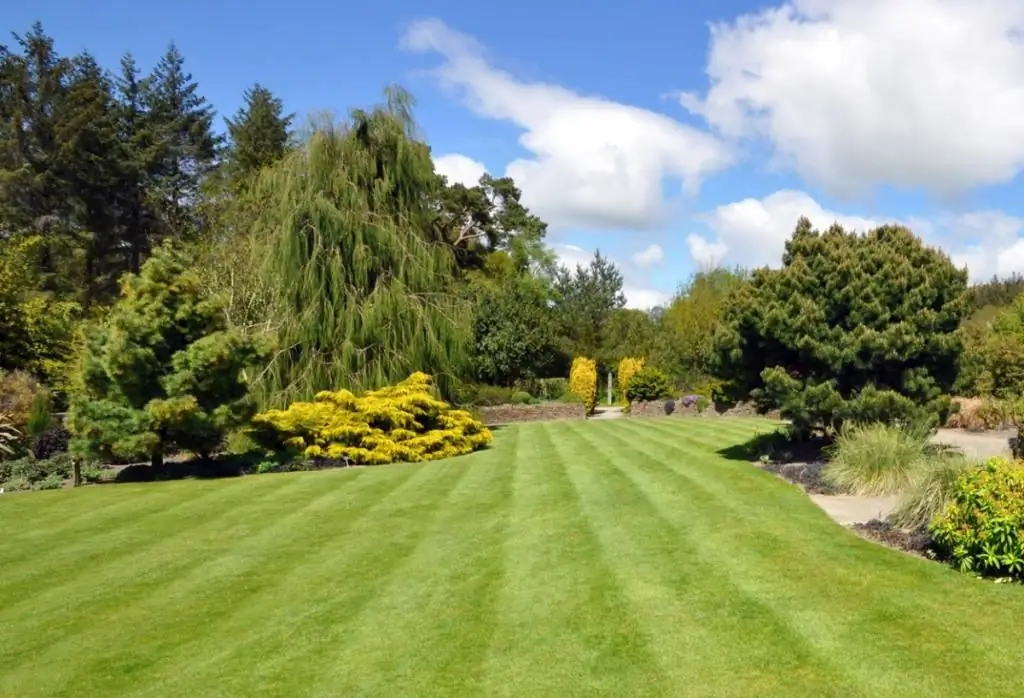
Grass sowing technology looks like this:
- Fertilizers for the lawn are applied before sowing seeds in a ratio of 1:4:4 (nitrogen-phosphorus-potassium).
- For 1-2 days before sowing, the upper fertile soil layer is well moistened, watered abundantly.
- Plow the seeds by hand or use a seeder. Do this while waiting for dry, calm weather.
- Having covered the seeds, roll the area with a roller. This procedure accelerates the emergence of seedlings and stimulates their further growth.
- At the last stage, mulch the crops with a thin layer (up to 0.5 cm) of peat or humus.
Don't forget to water the lawn every day until the first shoots appear - in the morning and in the evening at the rate of 10 liters of water per 1 m2 of the lawn. Having done everything right, focus on 7-21 days to see sprouting green grass. Although it depends on the type of cereals and the microclimate of the region.
As a result, you will get a beautiful and uniform green area that adorns your backyard or summer cottage. On such a platform, you can relax, sunbathe, have picnics, play active outdoor games, spend your leisure time interestingly, or set up a colorful flower bed with flowers or green plants 1-3 tiers higher surrounded by a lawn.
We hope this article will help you understand the main aspects of growing a lawn in a country house or backyardterritory on their own, without resorting to the services of landscape designers, whose work is not cheap.
Make your lawn easier with the tips and tricks in this article.






